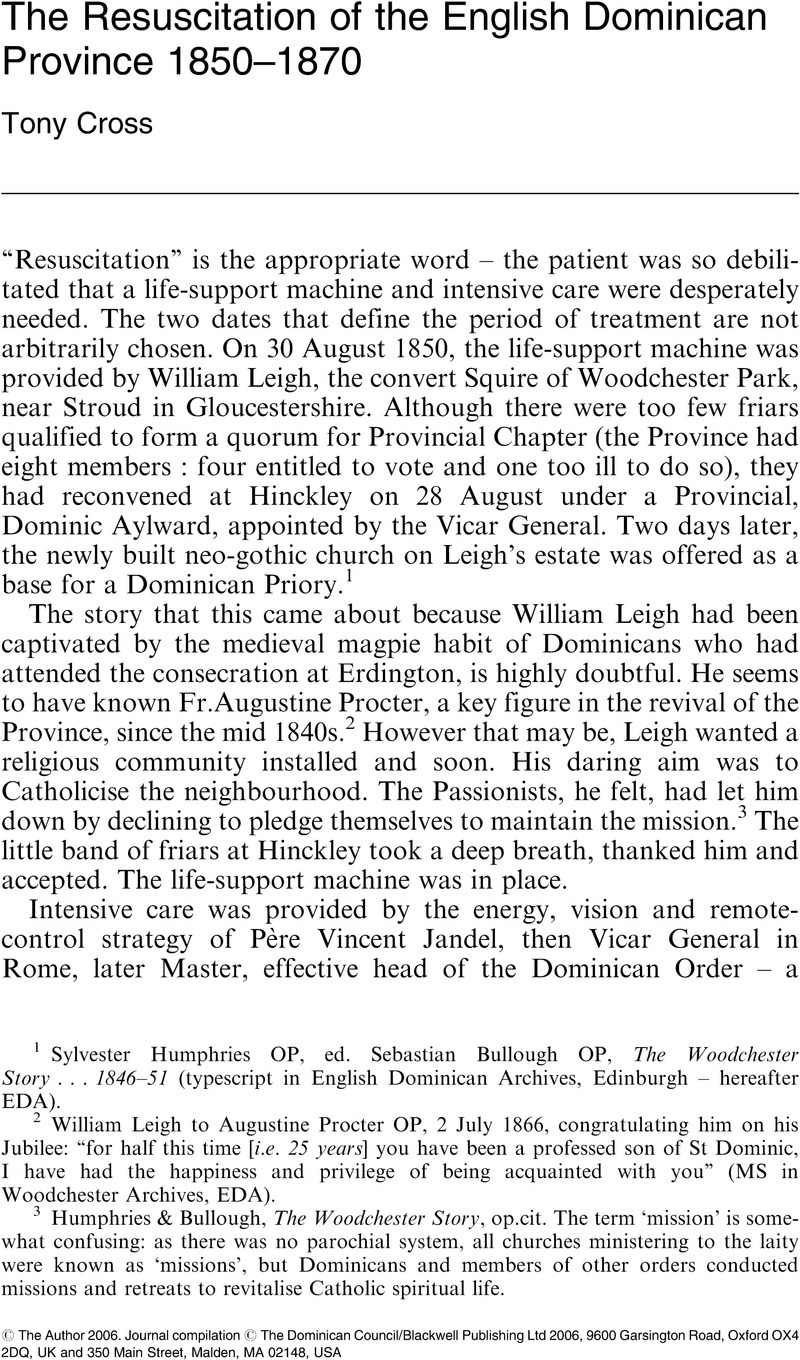No CrossRef data available.
Published online by Cambridge University Press: 01 January 2024

1 Sylvester Humphries OP, ed. Sebastian Bullough OP, The Woodchester Story…1846–51(typescript in English Dominican Archives, Edinburgh – hereafter EDA).
2 William Leigh to Augustine Procter OP, 2 July 1866, congratulating him on his Jubilee: “for half this time [i.e. 25 years] you have been a professed son of St Dominic, I have had the happiness and privilege of being acquainted with you”(MS in Woodchester Archives, EDA).
3 Humphries & Bullough, The Woodchester Story, op.cit. The term ‘mission’ is somewhat confusing: as there was no parochial system, all churches ministering to the laity were known as ‘missions’, but Dominicans and members of other orders conducted missions and retreats to revitalise Catholic spiritual life.
4 Tony Cross ‘Robert Rodolph Suffield's Dominican Decade 1860–70’, forthcoming in Recusant History.. His liberal religious neighbours and friends, Viscount & Viscountess Amberley were probably the most influential.
5 Suffield, Robert Rodolph, Five Letters on a Conversion to Roman Catholicism(Thomas Scott, 1873)Google Scholar. On p. 11 we read: “I left the Roman Catholic Church on the day on which Papal Infallibility was proclaimed.” A typical claim – in fact he left at least 20 days later.
6 English Dominican Province correspondence in Ordo Praedicatorum, Archivum Generale, at Santa Sabina, Rome – hereafter AGOP.
7 Jarrett, Bede OP The English Dominicans(Burns & Oates, 1921)Google Scholar see pp. 202–207; Bede Bailey OP, Simon Tugwell OP & Dom Aidan Bellenger, Letters of Bede Jarrett(Downside Abbey & Blackfriars, 1989) see preface pp. x, xi.
8 Alexandre Vincent Jandel OP to Dominic Aylward OP, n.d., but note on letter records it reached Aylward on 28 July 1866 (Jandel Letters, Book I, No.52, EDA).
9 Aylward to Antoninus Williams OP, 14 March 1870 (Newcastle Archives, EDA).
10 Aylward to Williams, 14 December 1869 (Newcastle Archives, EDA).
11 Aylward to Williams, n.d., probably early September 1869, before Newcastle Priory foundation stone ceremony.
12 Aylward to Williams, n.d., probably after Definitors’ Memorandum on the building fund for Newcastle Priory, 8 May 1868 (EDA). The Definitors were, in essence, the finance committee of the Province.
13 Jandel to Aylward, 3 April 1852 (Jandel Letters, Book I, No.15, EDA): “…je vous engage beaucoup à rendre à vos novices 7 heures de sommeil non interrompu de 8h. à 3h.”
14 Procter to Jandel, 6 November 1851 (AGOP XIII, No.10): “Les Anglais pieux aiment ordinairement de pousser le chose à bout…”
15 H.M.Capes OP, Father Bertrand Wilberforce, (Sands & Co., Edinburgh & London, 1906) p. 16. Arthur Wilberforce was Henry Wilberforce's son and grandson of William Wilberforce.
16 Austin Maltus OP to Procter, 18 April 1860 (EDA).
17 Drane, Francis Raphael OP, Life of Mother Margaret Hallahan(Longmans, 1929) p. 314Google Scholar.
18 Drane, Life of Mother Margaret Hallahan, op.cit., p. 239.
19 J.Fitz-Patrick, William, The Life of the Very Rev. Thomas N. Burke, OP(Kegan Paul, 1894), pp. 85–91Google Scholar.
20 Jandel to Aylward, 26 October 1852 (Jandel Letters, Book I, No.21, EDA): “Dites moi aussi si vous avez interdit le chant au fr Burke? C’est une mesure indispensable.”
21 A lector is a lecturer and tutor in the Dominican Novitiate or Studium House.
22 Jandel to Aylward, 18 October 1855 (Jandel Letters, Book I, No.39, EDA): “…cela tient sans doute à l’impressionabilité des natures Italiennes.”
23 Jandel to Aylward, 14 December 1853 (Jandel Letters, Book II, No.93, EDA): “…non moins zélé pour les études que pour l’observance…”
24 Jandel to Aylward, 29 June 1854 (Jandel Letters, Book I, No.31, EDA): “…vous connaissez assez tout l’intérêt que je porte à ce noviciat, qui renferme l’avenir de notre ordre en Angleterre.”
25 Suffield to Procter, “October 1860”(Procter Papers, EDA).
26 Jandel to Nickolds, 25 July 1864 (Jandel Letters, Book I, No.78, EDA): “Ho sentito con molto piacere che V.P. avesse licenziato buona parte dei postulanti di Hinckley.”
27 Nickolds to Aylward, 18 May 1863 (EDA): “…Fr. Bern. is gone abroad, and as he wishes to sink into oblivion I think it is better for us and no worse for him to allow him to do so.”
28 Bernard Morewood OP to Jandel in August 1860 (typescript copy in EDA of AGOP XIII, No.12 – my translation from French original).
29 Suffield to W.E.Gladstone, 30 January 1880 (Flintshire Record Office, GG 697). Miss Tasker had a papal title and the correct form, therefore, is ‘Countess Tasker’.
30 Lady Arundell to Aylward, 15 February 1869 (EDA)
31 Aylward to Williams, 5 January 1870 (Newcastle Archives, EDA).
32 Anonymous article, ‘The Association of the Perpetual Rosary’ in The Tablet, 14 October 1865, pp. 645, 646.
33 Peter Clarke, The Life of Elizabeth, Countess of Clare(privately published by the Isle of Wight Catholic History Society, 2002) see chapter 5, ‘St Dominic's Priory’.
34 Aylward to Jandel, 26 January 1869 (AGOP XIII, No.228): “Elle a été très gracieuse…”
35 Elizabeth Longford, Victoria R.I. (Weidenfeld & Nicolson, 4th impression 1987) p. 571.
36 Robert Suffield, The Holy Order of St Dominic, (Richardson, London, Dublin & Derby, 1860) p. 18.
37 Ushaw College Diary gives dates of conferment of orders (Ushaw College Archives).
38 Joachim Hyacinth Gonin to Jandel, 21 July 1860 (AGOP XIII, No.207): “Parmi ces vocations, il y a d’assez remarquable, elle de P. Suffield l’un des Prêtres de Newcastle, ayant une renomée de prédicateur…”
39 Procter to Jandel, 22 January 1862 (AGOP XIII, No.4)“…j’ai été presque seul.”
40 Anonymous (Suffield, probably assisted mainly by Raymund Palmer OP)The Crown of Jesus(Richardson, London, Dublin & Derby, 1862).Google Scholar
41 Aylward to Williams, 21 March 1870 (Newcastle Archives, EDA).
42 Meynell, Viola, Francis Thomson & Wilfrid Meynell(Hollis & Carter, 1952) pp. 1, 2Google Scholar.
43 Joseph Portley OP to Williams, 9 September 1870 (Newcastle Archives, EDA). Portley's underlinings are italicised.
44 Bede Jarrett's aunt (his father's sister) married William Leigh's son (Bailey, Bellenger & Tugwell, Letters of Bede Jarrett, op.cit.p.xvi).